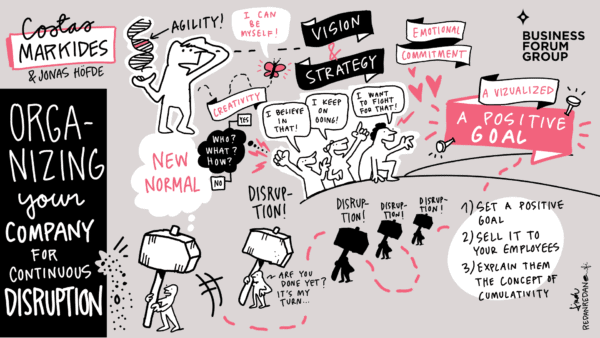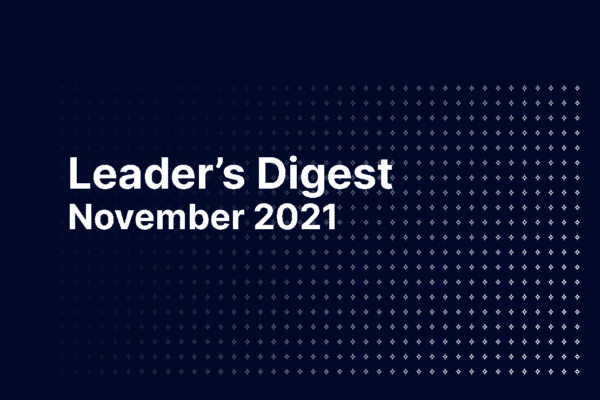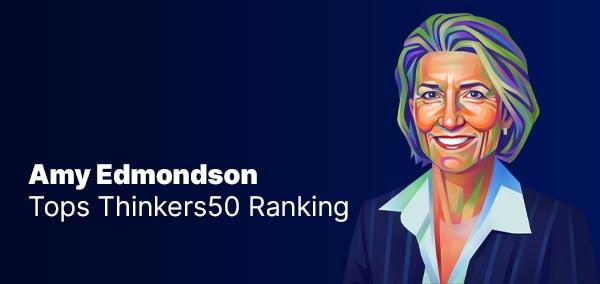11Nov2021
On 11 November, we joined forces with Oslo Business Forum and Devoteam Fornebu Consulting, to host a free webinar with Costas Markides, the Professor of Strategic Leadership at London Business School. Over the course of the session, he explored a few ways in which an organization can prepare for continuous disruptions. Here, we give you a summary of Costas’ keynote.
Costas began by underlining that the continuous and overlapping disruption has obviously created several challenges for organizations. During the webinar, he pointed out three and also provided some suggestions for leaders on how to tackle them. (If you are interested in learning more, Costas unravels more challenges and solutions in his new book Organizing for the New Normal.)
Challenge #1: How do you “energize” your people to be always ready for the fight?
“Continuous disruption requires continuous readiness.” According to Costas, the people in your organization need to constantly monitor what’s happening but also have the energy and positive attitude to respond to whatever challenge or setback may come your way. And how can you energize them to do that?
Costas suggested that in theory, we all know the answer just by looking at psychology. “You have to give people a positive goal to aim for. Not a negative goal to avoid, but a positive goal to aim for.” The key here is that as long as people believe in the goal, they will be willing to fight to achieve it no matter what issues they might face along the way.
But how can you motivate people in practice? Costas referred to the theory on how to create sustainable urgency for change. It includes these 3 steps:
- Give your people something positive to aim for.
- Sell it to them so that they “buy into it” (that is, you win their emotional commitment).
- Make people understand that the battles they are fighting are not isolated battles-cumulatively they lead to a positive goal.
“The theory is simple and straightforward. The problem is that most companies mess up step number 2.” Leaders often fall short in winning the emotional commitment for the goal as they think they can win people’s hearts with speeches and PowerPoint presentations.
“It never works. What works it’s other tactics, like visualization, storytelling, and symbolic actions.” He showed us the popular video that aims to fight against discrimination by showing a man giving free hugs to people on the street. “I’ve been watching this video for 10 years now, and every time I get goosebumps because it moves me on an emotional level. That’s the power of visualization.”
Instead of telling people, show them. “More important than giving people a goal, is selling people the goal.”
Challenge #2: Continuous Disruption Requires Continuous Innovation—How Do You Achieve that?
According to Costas, there are many things you can do to achieve this. But one effective way is to unleash the suppressed creativity that lies in every one of your employees.
He pointed out through research findings that all of us are born creative. The problem is that society suppresses this creativity when we grow older. This notion might sound depressive, but Costas sees the positive: “This is fantastic news! We are all creative—we all have it inside us.”
To continuously innovate, you just need to unleash this creative potential in your organization. How? Costas, with support from the field of psychology, argued, that the most important factor that influences how we behave is the environment. And it affects us much more than we think. So, in order to release that creative potential, you need to create an organizational environment that allows that.
Luckily Costas knew, what goes in our head when hearing that: but how?, we all asked. He implied that we should do it the same way we do it with our children at home. If you have children, you have probably been successful at this at least once, said Costas. You allow your children to make mistakes. You provide them the psychological safety to be themselves. You give them the space and freedom to bring out their creativity. So, all you need to do is to do the exact same thing at your organization.
According to Costas, the principle “children see, children do” applies at work too. He suggested that you should simply be yourself and show an example just like you do at home. “You’ll be amazed by the results. The little things you do get magnified by the people around you. And the small things you do in your organization have the potential to bring a big difference.”
Challenge #3: How to Provide Clarity in an Uncertain World?
Costas first underlined how this lack of clarity in management, in general, is a huge problem in organizations. He argued that although there are many reasons for this, the biggest reason is that people fail to make the strategic choices that strategy actually requires.
According to Costas, strategy is all about making difficult choices on the who, what, and how of the organization. Who shall you target as customers—and more importantly who shall you not? What shall you offer to these customers—and more importantly what shall you not? How are you going to play the game in terms of things like distribution and value chain—and how are you not?
Especially, if you want to give people autonomy to make agile calls, you need to give them certain boundaries and parameters within which they need to operate. And those strategic choices that Costas referred to can provide the parameters for your people. “But most companies do not make these choices.”
To provide clarity, Costas provided these four guidelines:
- When communicating strategy to people, focus on the choices.
- When you communicate the choices, give them also the alternative you considered in making that choice. “Say that we had to decide between customer X and customer Y, and we decided to go with customer X because of these reasons.”
- Avoid buzzwords and the good-sounding acronyms that everybody uses. “Assume that you are talking to your mother who didn’t go to business school.”
- Remember that communication is not one-way traffic. “It means that you need to engage your people in a discussion.”

Visual summary by Linda Saukko-Rauta

 by:
by: 
